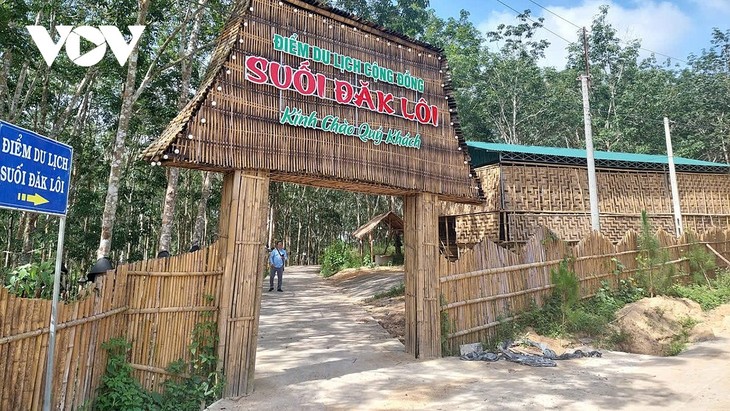Just 20 kilometers from the center of Kon Tum ward in Quang Ngai province, Kon Jong village of the Xo Dang ethnic people nestles peacefully amid lush rubber and coffee plantations and verdant forests. Flowing nearby is the picturesque Dak Loi stream - a destination for eco-tourists seeking a return to nature.

The gate leading to the Dak Loi community tourism site in Kon Jong village. (Photo: A Saly/VOV in Central Highlands)
The Dak Loi stream area is dotted with giant rocks, shaded by green trees, enjoys fresh air year-round, and has some enchanting scenery. Recognizing its potential, local authorities have designated it a community-based tourism site. With state support, villagers working under the Ngoc Reo commune’s Agricultural Services and Tourism Cooperative have built dozens of huts using natural materials and opened stalls showcasing local specialty products.
A Thao, Secretary of the Kon Jong hamlet Party cell and Director of the cooperative, says community tourism is opening new opportunities for the Xo Dang people. Locals are changing their mindset and approach to business.
“Within the village, for example, I’ve built nurseries to grow flowers and shade trees, distributed them to households, and encouraged the households to plant them along the roads and in their family garden,” A Thao told VOV, adding, “At Dak Loi stream, we regularly clean, plant trees, build huts, and request financial support for infrastructure from the higher-level authorities. So far, 20 members have joined the cooperative to develop tourism at the stream.”

Xo Dang ethnic people in Ngoc Reo commune perform gong instrument.(Photo: Ngoc Chi/VOV)
Villager Y Doan, tending the flower garden in front of her home, told VOV that since Kon Jong began developing community tourism, households have been better prepared to welcome visitors.
Since the cooperative was established, residents have paid closer attention to protecting the environment and reviving cultural traditions such as gong performances, folk singing, rice wine brewing, brocade weaving, and preparing ethnic dishes. “We’ve prepared rice wine, traditional dishes, and drinks for the tourists to enjoy. We want every visitor to remember us, so they’ll return again and again,” said Y Doan.
Ngoc Reo commune has seven hamlets with a population of 5,600, 99% of whom are the Xo Dang people of the To Dra branch. Their culture of gongs, xoang dancing, festivals, and crafts is closely tied to the mountains, fields, and forests and has been passed down through generations.
To develop community tourism, local artisans organize weekly gong and xoang dancing classes to prepare the younger generation for performances. The commune has restored its traditional rông (communal house), maintained troupes of gong players and xoang dancers of all ages, and continued traditional handicrafts like weaving, blacksmithing, and wood carving.

Ms. Y Hoa is by the Kon Jong Cooperative’s stall. (Photo: A Saly/VOV in Central Highlands)
Y Hoa, head of the rice wine making team at Kon Jong Cooperative, says the cooperative has set up stalls to showcase local OCOP products, which include honey, dried bamboo shoots, coffee, and rice wine – Kon Jong’s specialty.
“To better serve tourism, I now produce rice wine that retains its traditional flavor while ensuring food safety, complete with attractive labels and packaging. This new approach has generated steady income, encouraging other women in the village to join. We’ve expanded our sticky black rice cultivation to secure enough raw materials for wine production.”
Y Hoa used to make rice wine just for local consumption, but with demand rising because of online orders and tourism, rice wine has become a major source of income for her and many other women in the village. Brewed from sticky black rice grown locally and fermented with forest leaves, the wine has a distinctive flavor that’s popular with the tourists.
Minh Hue